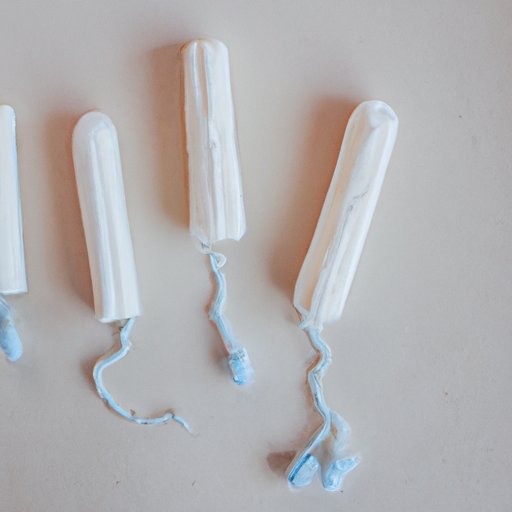
Introduction
Inserting a tampon for the first time can be intimidating, confusing, and even scary. But with some helpful tips and a step-by-step guide, you can learn how to use tampons comfortably and confidently. Tampons are preferred by many women for their convenience, comfort, and discreetness. It’s crucial to know how to use tampons properly to avoid pain, discomfort, or risk of infection. In this article, we’ll provide you with a comprehensive guide that covers everything you need to know about using tampons.
A Step-by-Step Guide on How to Insert a Tampon
Here’s a simple, step-by-step guide on how to insert a tampon:
1. First, choose the right tampon size for your flow (learn more about this in the next section).
2. Unwrap the tampon and hold it at the base with your thumb and middle finger.
3. Find a comfortable position, such as standing with one leg elevated on the toilet seat, sitting on the toilet, or squatting.
4. Use your other hand to open the labia (outer folds of skin) to expose the vaginal opening.
5. Gently insert the tampon into your vagina at a slight upward angle, using your index finger to push it in until the applicator is fully inserted.
6. Use your index finger on the applicator to push the tampon through the applicator into your vagina.
7. Remove the applicator and make sure the tampon is inserted comfortably and securely.
Tips for First-Time Tampon Users
If you’ve never used tampons before, it’s natural to feel nervous or intimidated. Here are some tips to help make the experience more comfortable and easy:
– Take deep breaths and try to relax your pelvic muscles. Tensing up can make it more difficult to insert the tampon.
– Find a comfortable position that works for you. Many women prefer to stand with one leg elevated on the toilet seat, but you can also try sitting on the toilet or squatting.
– Choose the right size tampon for your flow. For light flow, choose a light or regular tampon; for heavier flow, choose a super or super plus tampon.
– If the tampon is uncomfortable or feels “stuck,” don’t panic. Gently tug on the tampon string to reposition it or remove it and try again.
– Don’t be embarrassed to ask for help. Ask a friend or family member who’s experienced or even consider speaking to your healthcare provider.
Comparing Tampon Sizes and Types
Tampons come in various sizes and types to suit different body types and flow levels. Here are some of the common tampon sizes:
– Regular: for light to medium flow
– Super: for heavier flow
– Super plus: for very heavy flow
– Light: for very light flow or for the beginning or end of your period
– Slender: for a smaller vaginal opening or for teenage girls
There are also various types of tampons, such as applicator vs. non-applicator tampons, tampons with or without wings, and organic or non-organic tampons. Choose a tampon that suits your needs and preferences. Experiment with different sizes and types until you find what works best for you.
Common Tampon Mistakes to Avoid
Here are some common tampon mistakes that you should avoid:
– Inserting the tampon at the wrong angle: make sure to insert the tampon at a slight upward angle towards your lower back.
– Leaving the tampon in for too long: don’t leave a tampon in for more than 8 hours to reduce the risk of infection.
– Not changing the tampon frequently enough: change your tampon every 4-8 hours, and more frequently on heavier flow days.
– Forgetting to remove the old tampon before inserting a new one: make sure to remove the old tampon before inserting a new one.
Addressing Common Tampon Concerns
Tampon use is safe for most women. However, it’s natural to have questions or concerns. Here are some common concerns and answers:
– Can tampons get lost inside the body? No, the vaginal canal is only a few inches long, and the cervix at the end of the vagina prevents the tampon from getting lost.
– Can tampons cause toxic shock syndrome (TSS)? TSS is a rare but serious bacterial infection. To reduce the risk of TSS, choose the lowest absorbency tampon for your flow and change your tampon every 4-8 hours or more frequently on heavier flow days.
– Can I wear a tampon when I’m not on my period? No, tampons are only meant to be worn during your period. Wear panty liners or pads during light discharge days.
Making the Switch from Pads to Tampons
If you’re used to wearing pads, making the switch to tampons can take some getting used to. Here are some tips to make the transition smoother:
– Start with light or regular tampons if you’re unsure about the size.
– Experiment with different types of tampons until you find what works best for you.
– Don’t be afraid to start with pads and switch to tampons as you become more comfortable.
Conclusion
Inserting a tampon for the first time can be nerve-wracking, but with the right information and guidance, you can do it! Remember to relax, choose the right size tampon, use the proper technique, and change the tampon regularly to ensure comfort and safety. If you have any questions or concerns, don’t hesitate to reach out to your healthcare provider. With practice and patience, using tampons can become a comfortable and convenient part of your menstrual routine.





